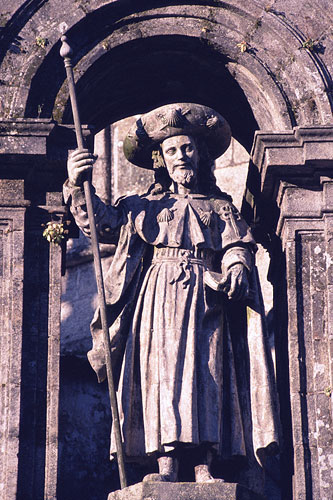On Saturday, June 4th, I'm boarding a plane with my dad and my daughter to begin a pilgrimage called The Camino de Santiago in northern Spain. I chose to go on this journey in order to step away from the everyday for a time and seek a quietness and simplicity that cannot be found in the busy-ness of life. Most people are relatively unfamiliar with The Camino, so I wanted to give a little background information on its history, the various paths, and some of what we'll encounter along The Way.

History - The Camino de Santiago, or Way of Saint James, is a pilgrimage to the cathedral in Santiago de Compostela. Saint James, an apostle of Jesus, was a missionary in this area, and, following his martyrdom, it is believed that his remains are preserved where the cathedral now stands. The Camino has existed as a Christian pilgrimage for over 1000 years and is recognized as one of the top three Christian pilgrimages in the world (with Jerusalem and Rome being the other two).
Routes - There are many routes of The Camino, but the most popular is the Camino Frances which traditionally begins in Saint-Jean-Pied-de-Port in France and runs west across northern Spain to Santiago de Compostela. This route is approximately 500 miles. We are walking the Camino Frances, although we will start in Pamplona. We will spend about 25 days walking as pilgrims, or "peregrinos", so our journey will not be entirely on foot. At some points along the route, we may intermittently take a bus in order to keep schedule and reach Santiago at the end of our 25 days. For those choosing to walk the entire 500 mile route, it usually takes 35-40 days of walking 12-15 miles per day.
Compostela - Pilgrims who walk at least the final 100 kilometers (60 miles) can receive a Compostela, or certificate of completion, at the Pilgrim's Office in Santiago. For us, this means that we must walk from Ponferrada to Santiago.
 Scallop Shell Symbol - The scallop shell is one of the most recognizable symbols of The Camino. Medieval pilgrims would carry a shell as a means of drinking water from the fountains found in each village. Today, the shell symbol is found all along the route to help pilgrims find their way.
Scallop Shell Symbol - The scallop shell is one of the most recognizable symbols of The Camino. Medieval pilgrims would carry a shell as a means of drinking water from the fountains found in each village. Today, the shell symbol is found all along the route to help pilgrims find their way. Albergues - The villages, towns, and cities along the route have many amenities to support pilgrims as they walk. Cafes and restaurants have a "Menu del Peregrino" offering a standard three course meal, usually with wine. Pilgrim's hostels, called Albergues or Refugios, provide a bed, a shower, and sometimes a meal at the end of a day's journey. Locals, as well as fellow pilgrims, wish you a "Buen Camino" as you depart to continue on your trek.
The song "I Would Walk 500 Miles" by The Proclaimers has been my theme song for this journey. I like to think of God saying He will go along with me as I walk "500 miles" to fall down at His door.
I'm gonna be the man who wakes up next to you.
When I go out, well I know I'm gonna be,
I'm gonna be the man who goes along with you.
But I would walk 500 miles, and I would walk 500 more,
Just to be the man who walked a thousand miles,
To fall down at your door.
No comments:
Post a Comment